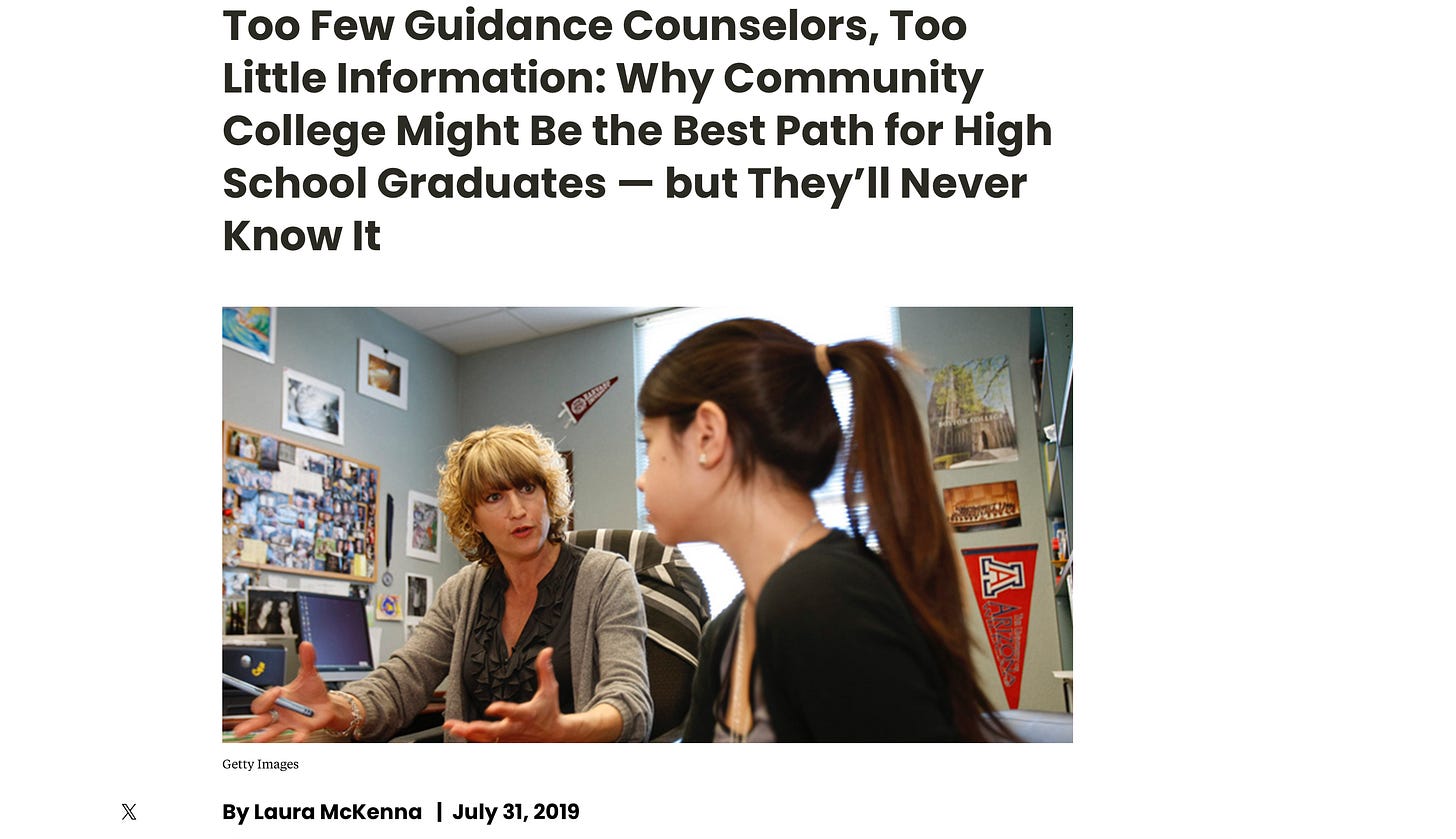When I wrote regularly for various magazines about schools, editors occasionally assigned articles about community colleges. With no personal experiences at these schools, I reached out to academic experts, community college presidents, and other advocates to do my research. Not surprisingly, they only told me the good stuff, so I wrote several articles talking about all the amazing opportunities at these special schools.
Then my son signed up for one class at our local community college in the Fall of 2021 after finishing high school. Accustomed to more highly resourced four-year colleges, I was shocked by this two-year college’s lack of administrative support and shoddy website. Also, I had to manage a major learning curve about the hurdles for getting support for students with disabilities at college, and the necessity of the accuplacer exam. Still dealing with COVID restrictions, much of the college remained online. My views of community colleges did a 180, and I wrote several negative newsletters about our experiences.
Two years later, my son has nine community college classes under his belt and is ready to go full time to finish his IT degree. I’m running a webinar tonight with administrators at the local community college to share information with parents and teachers. Now, I’m more accustomed to the downsides, and have returned to my original excitement about how these colleges can provide a low cost, low stress education for our kids.
In July 2019, I wrote about a report that found that guidance counselors didn’t know much about opportunities at the community college, and explored some reasons why.
A couple of years later, I wrote about an innovative program in Denver that got high school students through college and into a workplace. One of the aspects of the program was a dynamic interaction between the high school, community college, and business community. Sadly, I handed in the draft for that article in March 2020 and it was never published.
After doing all that research, I became a huge fan of these schools. They are inexpensive. They support students who planned on transferring, as well as students who needed training for the trades. It’s a place for second chances and gap years. I’m a sucker for schools that are aimed at the overlooked students.
I recovered from our bumpy start with our community college and become more impressed at all the opportunities there. It’s not the right place for every student with disabilities or learning differences. Students with high social needs will be disappointed by the lack of connections between students. Most community colleges don’t have dorms, so students who want more independence won’t be happy.
My son has low social needs and can manage the academics of math and technology programs without any assistance, but needs help with writing. He can take an uber to college in the fall and take classes for under a $1,000. He’s in a new program that will support his academics and help him transition to work. A four-year college would be too stressful with higher academic and social expectations. This is really the right place for him.
They have other programs for students, who can’t attend the regular college classes. Instead they’ll learn job skills working in a hydroponic farm. There are usual supports for students with mild learning differences. There is something for almost every kind of student.
For community colleges to be really successful — to go beyond the hype — they need tighter relationships with local high schools. Families must demand that information from their high school support system and seek out information independently. And voters need to pressure their state representatives to fund those schools adequately, so they can truly support our kids.
LINKS
Last week, I wrote about the limitations of “innovative” education policies.






I taught for over 10 years at community colleges in three different states (feel free to call me crazy) and have had administrative and educational experiences with colleges in three others. Some observations:
Maryland: for the most part, very good and an extraordinary value for the money at several locations, but beware the campuses in underserved/poor counties; Rhode Island: a cluster %$*! at almost all campuses while some are prettier and better resourced than others. I got a damn good second-career education here but only because I already had a BA, MA, and PhD so I knew my way around the system (including the Accuplacer); New York: pretty good over all but probably also dependent on location in relation to local poverty levels (it helps to attend one of the CCs near a SUNY center); Massachusetts: the program for ASD students that I work for seems to serve our students very well; Texas: I was not paying attention back then.
This leads me to . . . while I think it's valuable to look at the connection between CCs and high schools, I think it's also important to look at the relationship between the University system overall in different states and the community colleges that feed them, or maybe even whether they are treated as feeders at all. In Maryland, the CCs were (for the mmost part) very much seen and treated as feeders for a stste system that is trying to establish itself (and may have done so) as a "serious research university system" and compete with the likes of Johns Hopkins. I am not sure that this is the case for, say . . . . Rutgers (my experience on this one is extremely dated and contingent, but I do not recall ever being taught to think of the CCs as THE pathway to degree completion at Rutgers).
Also, as I will say over and over again: much of this relates to the adjunct crisis. At most of the places I taught, more than 90% of the faculty were adjuncts in my department. Regardless of things like disability services, you cannot provide a quality education to students, especially those with LDs, when your faculty do not have offices and are paid $2000/semester to teach a class. (My high regard for the Maryland system is not without some very serious caveats: check out the differences between adjunct faculty salaries at CCs in poor, predominatly black counties vs salaries in wealthy, white suburban campuses . . . it's a disgrace). California has some initiatives in place (by law, not just happy talk) to require certain lower percentages for adjunct and mandates (funded, or semi-funded) to hire FT faculty. I'm not sure how that is working out since I am out of the game (or off the hamster wheel).
Money. Money. Money. Plus, race, power, politics. Of course.